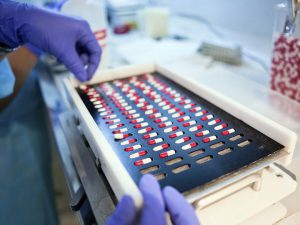- A poorly planned and executed development program for a rare disease misuses valuable patient resources and serves to delay obtaining the knowledge required to understand the benefits and risks of a drug to support regulatory review and approval FDA provides valuable advice and guidance to sponsors, we cannot require sponsors to follow our advice
- Sarepta’s approval of Exondys 51 in 2016 was a unique case where their drug did not have a well-controlled trial or any efficacy. With Sarepta, a grass-roots effort involving a a small but very vocal minority was able to influence high-profile individuals and administrator at the FDA to to bypass the normal review process and approve the drug. Path taken by Sarepta NOT a good model for other development programs
- Assays for biomarkers should be well validated before use to avoid obtaining misleading information and wasting clinical specimens Particularly true when invasive procedure required to collect tissue in children
- Rigorous blinding and control procedures should be in place to minimize bias in assay interpretation Protocol should specify blinding procedures, adjudication methods, independence of readers, etc.
- In many cases, randomized controlled clinical trials represent the fastest way to determine if a drug is effective
- Randomize as early as possible in development to avoid potentially misleading and uninterpretable findings from open-label trials
- Employ methods to limit time on placebo (e.g., dose-response, delayed start, randomized withdrawal, interim analysis)
- Report early trial results accurately, post hoc analyses of failed trials are generally hypothesis generating for next trial, not evidence to support approval
- Knowledge of natural history of disease critical to intelligent design of clinical trials for FDA approval of a rare disease.
- Conduct natural history trials before clinical trials begin
- If a natural history external control group is proposed, it should be identified prospectively to ensure comparability to treatment group
- Natural history external control group created post hoc is very difficult to interpret, unless effect of test drug is very large, due to known and unknown confounding
- Use of accelerated approval pathway should be prospectively planned, NOT as a “rescue” for a failed program Sponsor and FDA should agree on the surrogate and drug effect considered “reasonably likely” to predict clinical benefit before un-blinding data
- Just “Any” effect of a drug on a biomarker is not a basis for accelerated approval
- Ideally, the confirmatory trial to further define clinical benefit should be started before AA is granted to ensure the trial will be completed in a timely manner
- FDA encourages the engagement of patients and caregivers in helping to design development programs that will result in drugs that provide meaningful clinical benefit to those with disease
- Approval decisions must be based on data from adequate and well-controlled clinical trials, which may include PROs and other patient-derived measures
- Experience of patients enrolled in trials can be very helpful; discordant results between trial data and patient anecdotes are very hard to reconcile
- FDA is obligated in facilitating development of effective and safe drugs for rare diseases
- Upholding statutory standards for approval in face of hopes and desires of patients, families, sponsors, and investors is a very difficult job and a reviewer must separate themselves from non-scientific opinion, in keeping with the FDA’s scientific mission.
For more information on the latest FDA news, call an FDA Regulations Expert.

Vaping regulation:
On August 8th, 2016, the FDA ruled that electronic smoking devices (like vape pens and e-cigarettes e-cigarettes and other tobacco products like hookahs and premium cigars in the same way it regulates traditional cigarettes and smokeless tobacco making it more difficult for minors to vape, and requiring scientific reviews of some products) in a step to protect public health, all vaping liquids will be considered “tobacco products” and, as such, will not be available to consumers under 18 years of age.
Going forward, the FDA will be able to evaluate new tobacco/vaping products not yet on the market, help prevent misinforming claims by tobacco product makers, evaluate the components of tobacco products and how they are made, and communicate the potential dangers of tobacco products
E-cigarette use among adults has gone up about 12.6%, according to Centers for Disease Control and Prevention data from 2014.
Among the adults who tried to quit smoking that year, more than a half had tried e-cigarettes as an alternative, and more than 20% started using them. Only a little more than 3% of people who had never smoked tried them, but what has troubled public health leaders is the news that people between ages 18 and 24 had the highest number of new users.
With the new regulations, people under the age of 18 won’t be able to buy these products in order to prevent lifelong nicotine addiction in America’s young people. The vaping and tobacco products will also have to come in child-resistant containers. Vaping liquids come in flavorings specifically tailored to children including: cookies and cream, atomic fireball candy, and. gummy bears.
Research has showed that e-cigarettes have become a problem for children. This year, the CDC found that e-cigarette use had tripled among teens in just one year, and recent investigation found that teens who used them were more than three times as likely to smoke conventional cigarettes a year later, which is greatly troubling.
In 2014, the CDC found that the number of calls to poison centers about e-cigarettes had risen steeply. Most of those calls involved children under the age of five swallowing the liquid or getting it into their eyes or on their skin.
The new 2016 regulations also mean that the government can have a say in what goes into the products.
Before the 2016 FDA regulation, there was no law mandating that manufacturers tell you what you are inhaling when you try one of their commodities.
